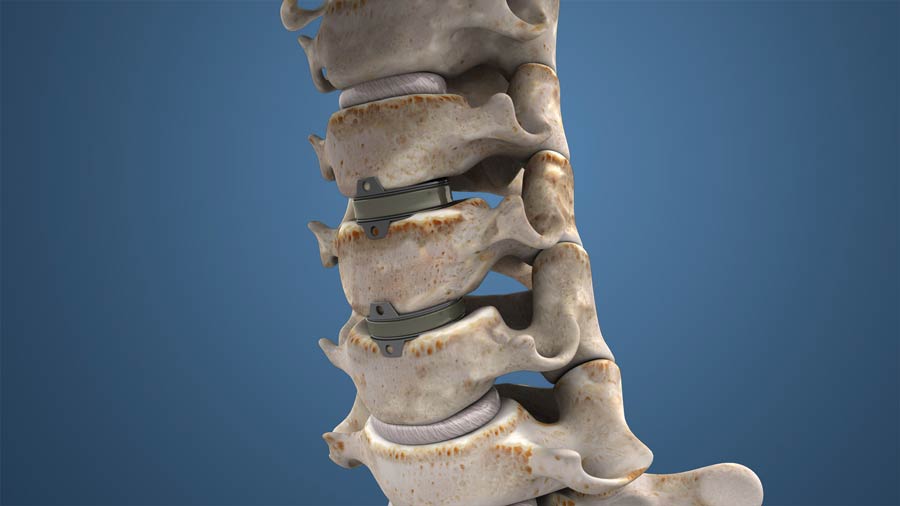Artificial Cervical Disc Replacement
In this video/blog, we’ll be taking a look at the recent research on cervical artificial disc replacement (ADR).
Purpose
If you have persistent neck pain with shooting arm pain that has not improved despite the appropriate treatments prescribed by your doctor, it can be frustrating. For a specific group of people, an artificial disc replacement may be an option.We should avoid sugar coating this discussion. The decision for ADR is not one based solely on pain and frustration. It works well for specific complaints coupled with specific findings on tests and physical examination. Understand your complaints, and have the discussion about the chances of surgery success with your doctor.
Surgical Technique
A cut is made to the front of your neck, and your surgeon will carefully move the muscles, arteries, wind pipe and food pipe away from the front of your spine. The specific disc and the corresponding boney vertebrae are identified.

The surgeon will enter the vertebral disc space, and mark the center of each of the two adjacent vertebrae. This helps facilitate accurate placement of the implant. A self-retaining retractor is placed over the disc space and a discectomy and decompression are then performed. Once the disc is removed, the spinal cord and nerves are unpinched. Extra steps are taken to ensure proper fit, placement, and positioning of the artificial disc implant.

Specific indications, contra indications
Depending on the patient, cervical artificial disc replacement may be preferable to cervical spinal fusion surgery. If you have intolerable nerve pain, despite time, activity changes, therapy and medication treatments, and diagnostic tests such as MRIs or CT scans demonstrate a pinching that corresponds to your physical exam findings, you may benefit from surgery. Your options may include removal of the disc and replacement with an artificial disc implant. But each person must consider their individual considerations before selecting the disc replacement option. Remember, there is never a guarantee, and you, the patient, must understand why a disc replacement, vs a traditional fusion, versus no surgery would be recommended. There may be nuanced differences, but some situations would cause a surgeon to recommend one option over another. For example, patients with poor bone quality or auto fusion findings are not good candidates for a disc replacement.
Longevity of disc replacement

Although there is data that demonstrates the favorable short-term outcomes of cervical ADR, there are very few studies that have monitored the long-term outcomes of this option. A few long-term studies show superior Disc replacement outcomes compared to fusion surgery, a promising future for ADR. The concern is that ADR surgery may need better implants to minimize the wear and tear of the implant and to extend its longevity. The rationale for ADR is the preservation of the motion, thus decreasing the stresses on the adjacent level. Theoretically this should avoid or lessen future complaints associated with degeneration of the level below or above the artificial disc implant.
Prevention of adjacent level disease
In a two-year post-surgery follow up study, 2 level disc replacement patients showed a lower incidence of adjacent segment disease and lower rates of reoperation compared to that of a standard two level fusion. In general, cervical disc replacements showed better outcomes compared to that of fusion. We must be cautious about this short term study, but the results are positive. The FDA has approved two level ADR for certain devices. Longer term data still needs to be reviewed regarding ADR for more than two levels. While the preliminary data looks encouraging, it is still too soon for approval. In the future, hopefully, ADR’s will prove to lessen the development of adjacent level complaints.
Conclusion
Compared to five years ago, ADR is becoming more mainstream with some studies showing better outcomes for 2 level operations. Long-term studies still need to be conducted to ensure consistency of outcomes and to prove the longevity of the replacement. The results thus far have been promising. CDR may be a reasonable option for those considering cervical disc surgery. But always remember there are risks, benefits, and alternatives to every situation. Even more so as technology continues to advance. Just make sure you’re selecting the best option for your particular situation. Remember that the reason for use of the technique, or the choice to NOT pursue an operation are legitimate issues that should be explored by anyone considering any form of surgery. Until next time, this is Dr. Shim.
Additional Resources:
Last modified: October 1, 2021









